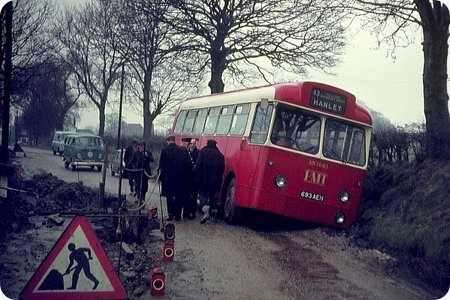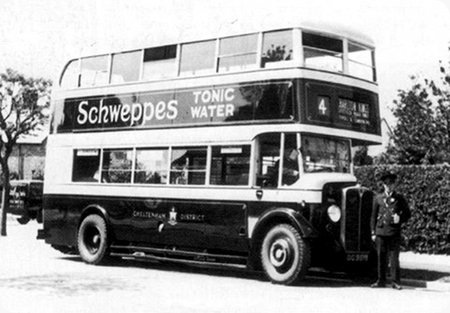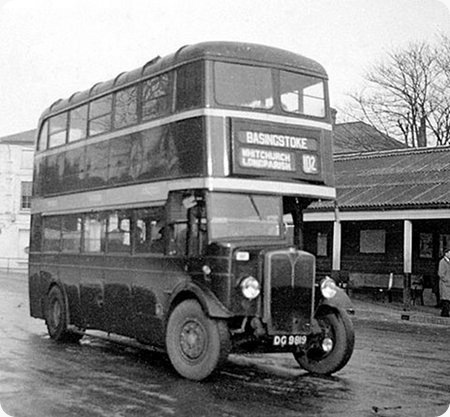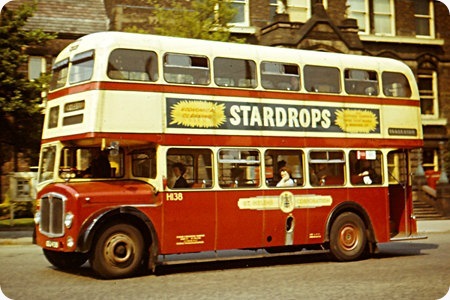PMT – AEC Reliance – 693 AEH – SN7693
Potteries Motor Traction
1957
AEC Reliance 470
Weymann B44F
This is one of many AEC Reliance 470 with standard BET style Weymann bodies (B44F) operated by PMT. This particular example dates from 1957 denoted by the 7 prefix to the fleet number. Allocated to Milton Depot at the time, it has come to grief sliding into a ditch adjacent to some road works whilst on an inward journey on the 43 from the village of Stanley to Hanley – which is the main town of the Stoke on Trent conurbation. Milton Depot had an allocation of about 20 buses, mainly single decks for services such as the one shown plus three lowbridge Atlanteans and I think three MCW highbridge Leyland PD3/4 for the Hanley to Abbey Hulton services. Inside the depot was a survivor – engineless AEC Regal ex fleet number S315 KEH 608 which was in use as the staff canteen. It later went to Hollis of Queensferry for preservation – wonder what happened to it? Going back to SN7693, I remember a call we took concerning a bus on fire somewhere out in the Staffordshire countryside. It turned out to be SN7680 of the same batch but by the time we reached it in a narrow country lane all that remained was a chassis – and some burnt grass banks either side of the road.
Photograph and Copy contributed by Ian Wild
These were the last batch of this type of body they had stick operated doors, Newcastle garage finished up with SN7688 which I would drive often as I thought it was a much better bus than the new Reliances we had with Alexander bodies, it had a good exhaust on it too.
Michael Crofts
Strange you should mention stick operated doors because Trent’s Tiger Cubs of the 1950’s had them. I remember thinking they had two gear sticks! The one to the right of the driver was forward when the doors were closed and then pulled back (a good pull was required!) and this pulled a flexible wire through a tube to open the doors, which were a mixture of jack-knife and two-piece. I often wondered if many fleets specified this apparatus. It fell out of favour by the end of the 50’s when something more sophisticated was felt necessary!
Chris Barker
Sheffield Transport amassed quite a fleet of Leyland Leopard Coaches between 1959 and 1961 with Weymann Fanfare, ECW and Burlingham bodywork. I did not have much cause to travel on them but I do remember that some, at least, (including the Weymann?) had this stick operation to their doors. These were full coaches with proper, heavy, coach doors – in the days when no coach had air assisted doors.
David Oldfield
My recollection is that earlier PMT Weymann bodied Reliances SN5573-5612 had electrically operated doors. I think lever operated doors commenced with SN6627-6646 and continued right through single deck deliveries including the 34 Albion Aberdonians until the ‘Jubilee’ batch SL801-810 when power operation recommenced. We avoided OMO conversions on lever door vehicles for as long as possible and of course the Aberdonians were never modified for OMO.
David mentions the lever operated doors on the Sheffield Leopards and I can recall a trip out to Bakewell on one of the B fleet Weymann Fanfare vehicles when fairly new (probably early 1960) where a friend and I sat on the front nearside seat and assisted with operating the door by hand as the driver was having difficulty with the lever operation from the cab!! The Fanfare vehicles were never modified to power operation whereas the Burlingham and ECW batches were later converted for OMO which included power operated doors.
Ian Wild
All the AEH reg batch AECs had the stick doors along with all the Albions.
Michael Crofts
With the delivery of 25 Alexander bodied Reliances in 1961, this brought a total to 150 of the 30 foot Reliances at PMT, most having Weymann bodies apart from another 10 Willowbrook bodied ones.
Michael Crofts
10/12/11 – 14:58
There were also a few Albion versions with this body operating Chell to Longton at this time. All three, Leyland, AEC and Albion had their own distinctive engine sound.
Anyone know who made the engines for the Albion?
Mr Anon
11/12/11 – 06:57
The Albions would have been Aberdonians – light-weight Leyland Tiger Cubs. The lightweight was in axle and chassis construction. They both shared the same Leyland Comet engine (0.350 version). Albions always had Albion gearboxes. [At different times, the Tiger Cub could have either a Leyland or an Albion box.]
David Oldfield
11/12/11 – 06:59
The Albion Aberdonian was a lighter weight version of the already lightweight Leyland Tiger Cub. It was powered by the Leyland O.350 engine of 5.76 litres giving 94 bhp, and was coupled to the Albion five speed constant mesh gearbox. It proved to be something of a frail beast, and most of the operators that tried it didn’t come back for more. Production ceased around 1960.
Roger Cox
11/12/11 – 11:20
The Albion Aberdonian had the same Leyland engine as the Leyland Tiger Cub, but strangely no Tiger Cub growl.
Peter Williamson
11/12/11 – 16:11
I always preferred the Aberdonian to the Tiger Cub, partly because I was brought with them. North Western’s batch of six spent most of their lives at Oldham depot and were the mainstay of the Saddleworth local services, running past my front door every half hour. I always thought they were quieter than the Tiger Cub and in retrospect I put that down to the Tiger Cub’s fan, although I don’t know if I’m correct in this.
The Albions had, shall we say, a distinctive vibration when idling. The only Aberdonian in preservation to my knowledge is the East Yorkshire one and that made the same sounds despite having a different body. It’s a bus I haven’t heard of for many years – does anyone know of its current status?
There are a few pictures of North Western’s Albions in my Saddleworth Buses gallery at: //davidbeilby.zenfolio.com/ where they will be found in the 156, 157 and 158 collections. (This gallery is still developing but the collections relevant to these buses have been done.)
David Beilby
13/12/11 – 08:58
I too had a soft spot for the Aberdonian, despite my only first-hand experience of them being the Manchester ones with Seddon bodies of almost third-world standard. I always feel that the model had a rough deal being marketed as an alternative to the Tiger Cub, as an urban bus or express coach, when it would have been much happier doing the sort of jobs that Bedfords did – pottering around villages on market days or providing day trips to the seaside – but giving the passengers a more refined experience than a Bedford could.
As far as I know, Plaxton-bodied Aberdonian coach XUP 692 is still with us, but it now very audibly boasts a Leyland 401 engine, and by all accounts goes like a rocket. I wish one of the Charlie’s Cars Harringtons had survived.
Peter Williamson
13/12/11 – 11:21
There’s an idea for another thread on the web-site – re-engining with similar, but different and larger, engines. I am already aware of AV760 powered RTs and RMs!
David Oldfield
15/12/11 – 06:52
When I drove for Stanley Gath of Dewsbury he had an ex O.K Motor Services Roe bodied AEC Reliance RUP 768 that had a rod operated entrance door. The bus was always called Rupert for obvious reasons.
Philip Carlton
26/04/14 – 07:24
I used to go to work on the Albions from Chell to Hanley and the gearbox seemed to be arranged from right to left, very different from the Leyland and AEC.
Can anyone verify this?
Clive Reynolds
27/04/14 – 08:06
Clive, the gear selector gate on the PMT Albions was exactly the same as any other bus in the fleet. They had a five speed Albion constant mesh unit fitted. The linkage was very sloppy giving the effect to the driver of stirring a very thick pudding when trying to locate each gear!
The Tiger Cubs that were acquired from Stratford Blue in 1971 had exactly the same gearbox but with a Leyland designed selector arrangement. The gear change on these was much more positive (and heavy!) but once you acquired the knack, I always thought a pleasant bus to drive. Mind you, I didn’t have to operate them in service on one man services.
Ian Wild
18/03/20 – 06:53
With regards to the electric operated doors, SN5573 to SN5612 plus SN6627 to SN6646 were so fitted.
Leekensian
Quick links to the - Comments Page - Contact Page - Home Page





